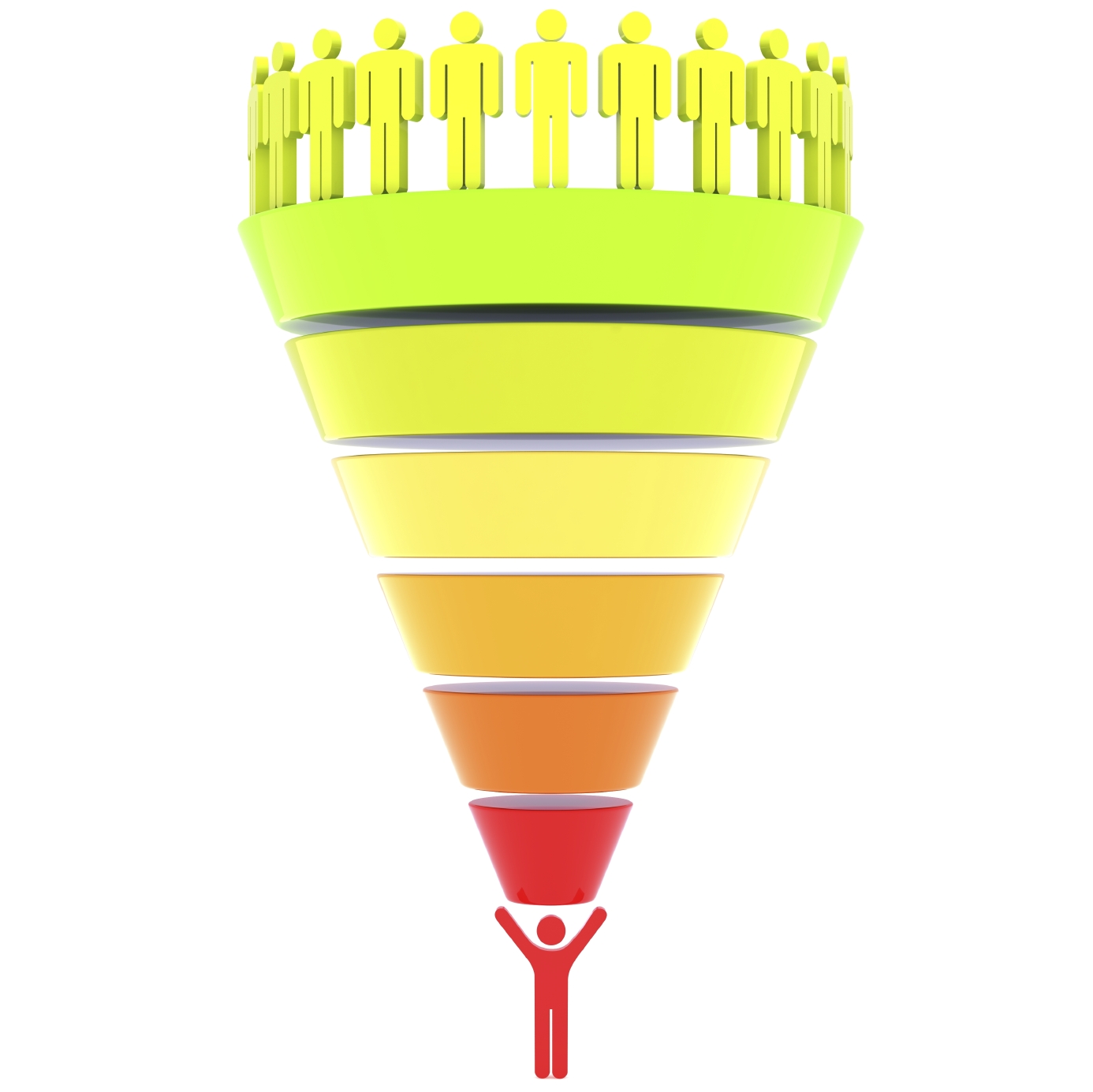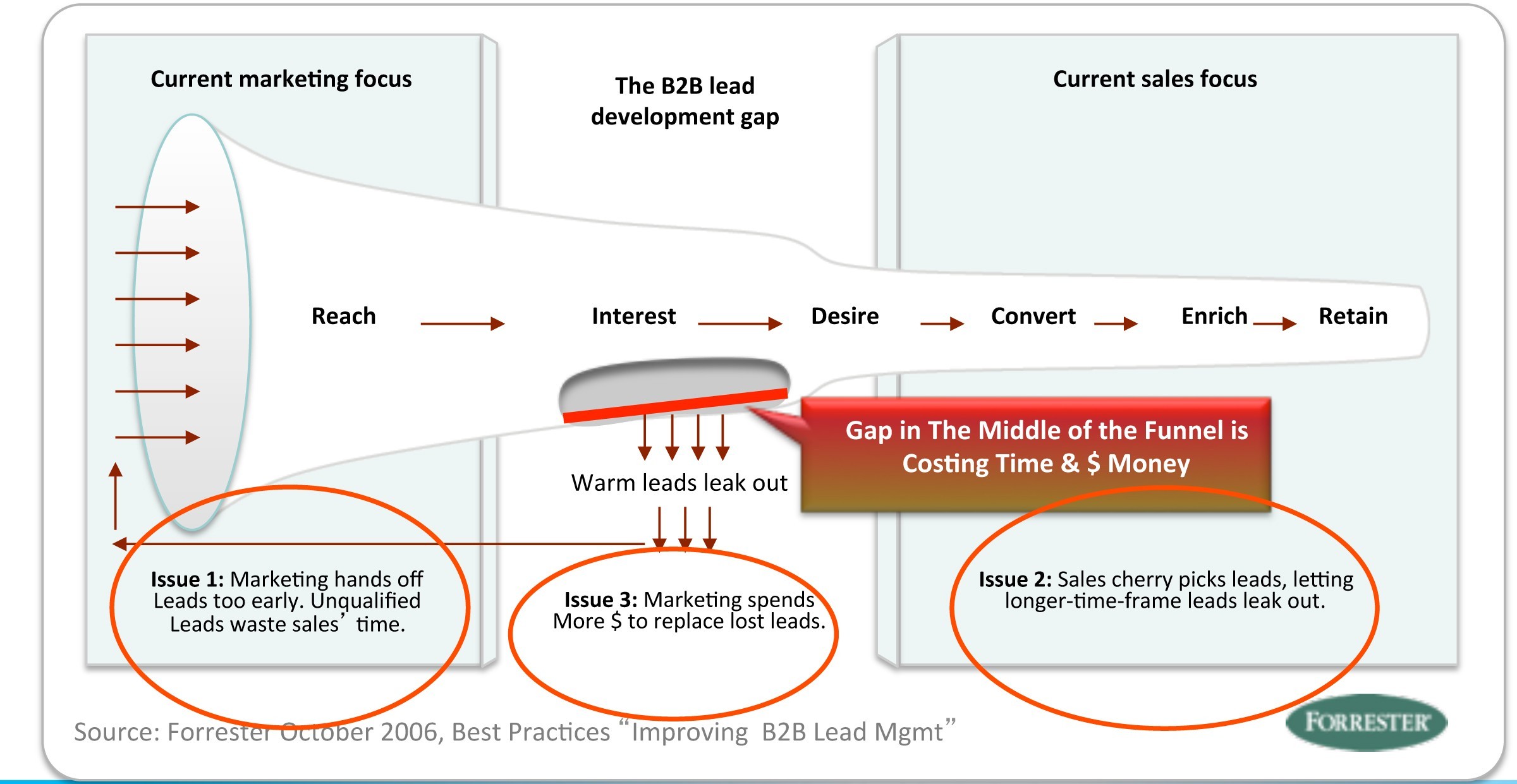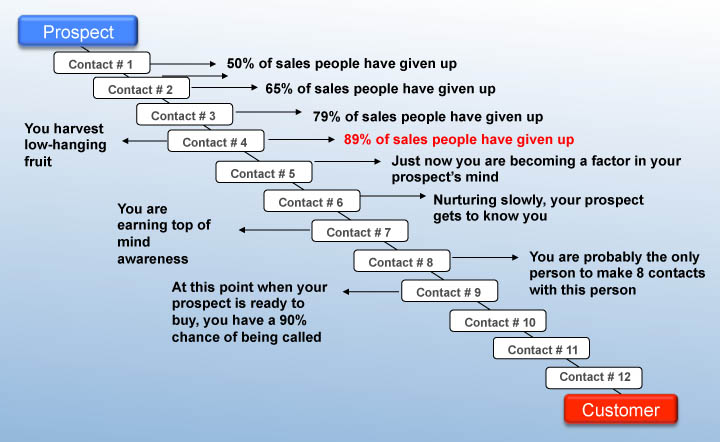By Laurie B. Beasley, Co-Founder and President, Beasley Direct Marketing, and Tom Judge, Vice President Strategy, Direct Marketing Partners 
Delivering a Qualified Sales Lead
You might think we’re exaggerating. However, we’ll show you how easy it is to reach 13 or more touches just to get to the point where a lead has provided enough information about his or her situation to be certain that the lead is really a “sales-ready lead” and not just a suspect name. Before we get to the seven to 13+ touches, let’s examine why the majority of today’s B2B “leads” never become prospects: the disconnect between Marketing and Sales. Nail the following and you’ll be miles ahead of your competition.
Sales and Marketing Live in Separate Worlds
According to CSO Insights, the average number of sales reps making their quotas was 63% for 2012. While only 42% of firms met or exceeded their 2012 revenue goals. Yet 92% of firms are raising their revenue goals for 2013—and more than 40% of firms indicate the increases are 15% or more. We can safely say there is a widening gap between Management’s revenue expectations and demands and Sales’ and Marketing’s ability to deliver. Unfortunately, instead of teaming up, Sales and Marketing are also experiencing a widening gap of credibility. Marketing points to the huge number of leads entered into the marketing automation system to prove that Marketing is doing its job. Sales points to the poor quality of the leads to prove that Marketing is not doing its job. Forrester Research says that low-quality leads create sales problems. Essentially, Marketing is pouring unqualified leads into the top of the sales funnel. Sales reps aren’t following up on the leads because there is not enough opportunity background data associated with each lead to justify real sales efforts. Time really is money in the sales business, and no sales rep will waste time on a lead unless they know that the person in question has some version of budget access, authority and—most of all—need for the product and a timeframe within which they plan to purchase. As Forrester sees it, warm suspect leads are falling out of the middle of the funnel, forcing Marketing to scramble to replace the leads and giving Sales very few real sales-ready opportunities with which to work. (See Figure 1.) Sales and Marketing are disconnected, and few leads are actually converted. Marketing costs go up, sales go down, and needless to say, Management is not pleased.
The Funnel
Figure 1: Low-Quality Leads from Marketing Create Problems for Sales 
Source: Forrester Research
Most Prospects Never Receive Enough Touches
Why do warm leads drop out of the lead-to-sales funnel? Because they have not received enough touches with information exchanged to convert them to a sales-ready lead. Consider the following typical sequence of developing a sales-ready lead:
1. Initial email campaign.
2. Initial direct mail campaign.
3. Call: prospect not there; leave a message.
4. Send email follow-up.
5. Call: prospect is not involved in any way and refers to correct contact in company.
6. Start over. Call the referred person, leave voice message.
7. Send email follow up. First email.
8. Call, after no inbound response: prospect not able to talk then, but schedules another time.
9. Send email follow up confirming call appointment day and time.
10. Conference call held. Prospect interested, but wants more information before all the qualification questions on script (which the sales team needs) are completed.
11. Send personalized email follow up with relevant info. The email may include information on case studies, webinars, and web pages with supporting information about the product. (AKA, mid funnel content.)
12. Prospect now ready for a peer-to-peer talk about needs/pains, access to budget, purchase authority, level of urgency and timeframe. Now, the scoring data says the prospect is sales-ready qualified!
13. Email to confirm appointment scheduled with field or inside sales rep, CC rep.
Quickly Get 13 or More Touches
You can get to 13 or more touches very quickly. The problem is that most so-called “leads” rarely receive any touches beyond receiving an email and filling out a response form. Some of those unqualified leads that Marketing tosses into the sales funnel are good potential leads, but they rarely receive enough touches to become qualified. Warning: don’t expect your sales reps to do this pre-sales qualification work. As we said, sales resources are slim and they are also some of the most expensive fixed costs in a company. Need more evidence? Microsoft conducted a study that shows that by the fourth contact, a full 89% of sales people have given up. (See Figure 2.) Figure 2: Most Prospects Never Receive Enough Touches To Become Leads 
Source: Microsoft
This is because not enough pre-sales qualification work has been done before Sales receives the lead. Lead-generation and qualification is hard work because it takes time to gather the qualification information and build a relationship with the prospect just to set that critical first appointment. Sales people haven’t got the time—and they won’t spend the time to build a relationship until they have the data that tells them the lead is solid.
If Sales Won’t Work with Unqualified Leads, Who Will?
What can we, as marketers, do about this disconnect? Marketing’s efforts to generate leads, according to Microsoft, are largely being wasted. There are plenty of leads, but most never get to the point where Sales will work with them. Our solution to this problem might seem heretical to some, but we stand by it: Marketing must step up to the job of pre-qualifying leads to this higher level before they are passed on to Sales. “Wait!” you might say. “The Sales Department has always done the qualifying, not Marketing.” But times change, and so do the rules of the game. Historically, Sales and Marketing have often been at odds.* Sales and Marketing must learn how to be each other’s BFF if either wants to meet management’s expectations. Because salespeople will not follow up on unqualified leads, Marketing must step up to the job of pre-qualifying leads by determining the BANT data (Budget, Authority, Need and Timeframe) or your company’s version of it, for each lead that comes in. This also puts the level of qualification information to be gathered beyond what can be gleaned from marketing automation systems and digital-only methods.
“Hang on!” you might say at this point. “We don’t have the people or the budget to do that kind of thing!” Right. That means you have to get the budget from Management to outsource this function with experts. Or, hire the fixed-cost staff and systems to do it. And you know what that means? You must justify the added expense with some cold, hard facts and numbers that prove the ROI of adding pre-qualification to Marketing’s roster of duties.
More to Come!
In our next posting, we’re going to talk more about BANT data and lead qualification. We’ll share information on how most marketing automation systems ARE NOT able to produce real sales-ready leads. Furthermore, we’ll learn why this happens to most firms. And finally, what adjustments can be done to deliver on the sales-ready promise. In subsequent posts, we’ll show you how to justify the expense of adding pre-qualification of sales leads in the Marketing Department. Also, ways to shorten the lead-generation process, and a couple of case studies that demonstrate the success of our approach will be examined.
* * * *
About the Authors

Laurie B. Beasley
This blog was authored by Laurie B. Beasley, co-founder and president of Beasley Direct Marketing, Inc., and Tom Judge, vice president Strategy at Direct Marketing Partners. Laurie and Tom will be presenting a mini-workshop on the topic of boosting qualified lead generation at DMA13.
Beasley Direct is a Silicon Valley direct marketing agency that has managed search, email, online, and demand generation campaigns for nearly 100 companies. Ms. Beasley serves as President of the Direct Marketing Association of Northern Californiawww.DMAnc.org. She manages the eMarketing Roundtable for the BMA Northern Californiawww.NorCalBMA.org. She is also an instructor of online marketing at UC Berkeley Extension and teaches for the Online Marketing Institute. Ms. Beasley frequently speaks on online marketing and demand generation topics for marketing organizations, including the DMA, BMA, AMA, Tech Council, and the Online Marketing Summit.

Tom Judge
For more than 20 years, Direct Marketing Partners has blended the human touch with marketing automation and sophisticated analytics to help our clients go to market and connect with their target audience. Tom Judge’s primary role and responsibility is to provide clients with direct marketing service solutions that best achieve their ROI goals on marketing and sales investments.
Tom Judge
Tom joined DMP in 2005 after fifteen years of consulting, design and implementation of best-practice lead generation and lead management programs. In addition, he is a Marketing Instructor at University of California and San Jose State University with the Direct Marketing Certificate Program.
Tom serves on the board of the Northern California Direct Marketing Association and has spoken and led workshops at the American Marketing Association, Business Marketing Association, Direct Marketing Association and the American Teleservices Association. He holds a degree in Marketing from Southern Illinois University and has performed Graduate work at Webster University, St. Louis, MO. He is a member of the Sales Lead Management Association’s list of the 50 Most Influential Sales Lead Management Professionals.


very informative. thank you so much!